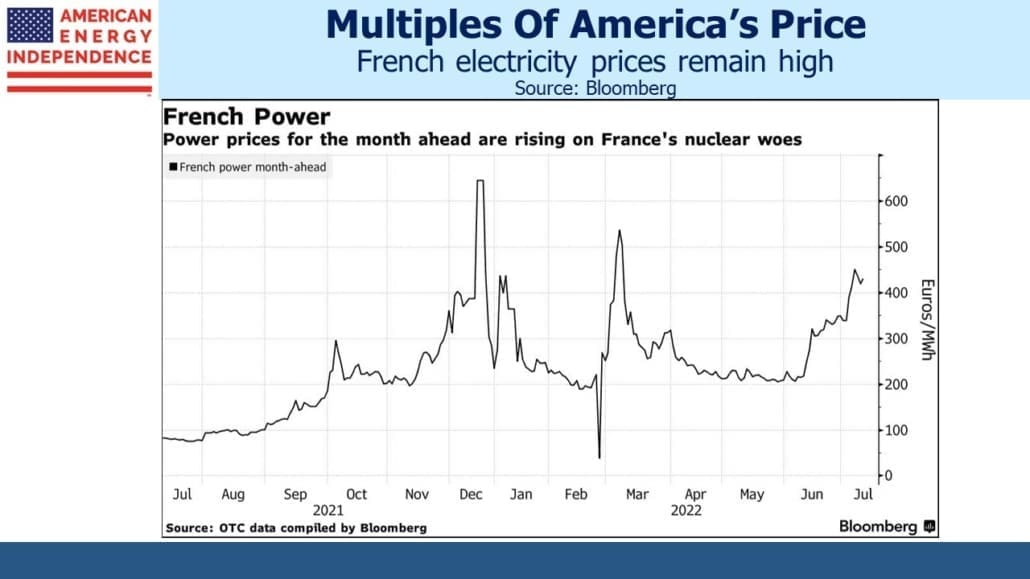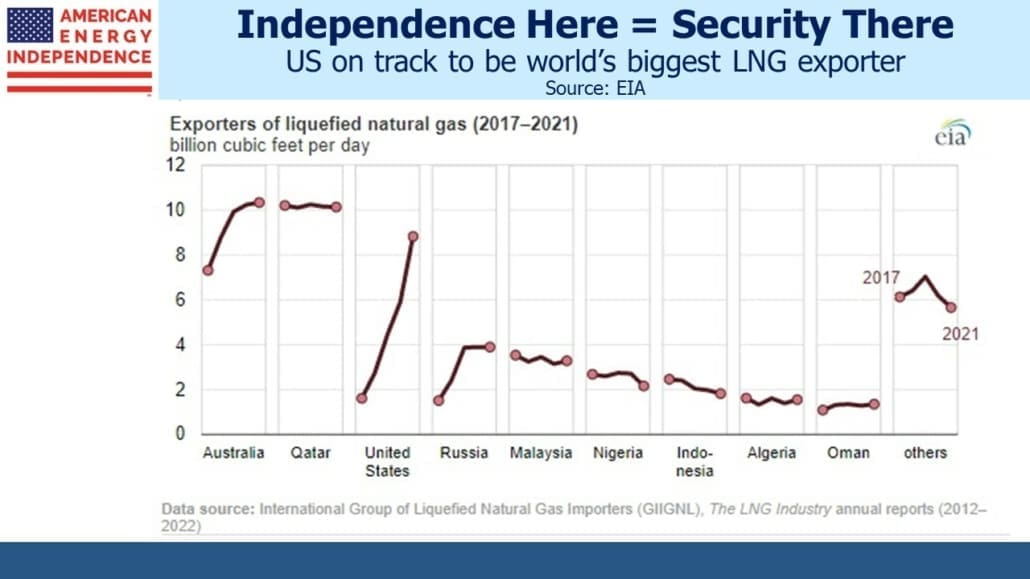Hoping Russia Will Send More Gas

/
On Monday Nord Stream 1 was shut down for annual maintenance, cutting off the remaining Russian natural gas exports to Germany. Europe’s biggest economy continues to provide lessons to the rest of us on what a flawed energy strategy looks like. German industry anxiously waits to see whether some contrived additional repairs will extend the pipeline’s maintenance beyond its scheduled ten days. Germany is dependent for energy on a country whose soldiers are being fired at by Ukrainians using German weapons. It’s not a good place from which to negotiate.
Austrian energy company OMV said it’s receiving less than a third of the natural gas from Russia that it’s ordered.
German day ahead power is trading at €370 per Megawatt Hour. French month ahead power is over €430. Europe’s problems are being compounded by a heatwave which is forcing reduced nuclear output in France. When the river water used to cool nuclear plants rises above a certain temperature, returning water back to the river risks damaging the environment.
Right on cue, west European wind power is falling too. Hot weather tends to occur with little breeze. That’s why it’s hot. Texas is experiencing a similar drop in wind output during their current heatwave, with output running at only 8% of capacity. It is possible to want reduced CO2 emissions while valuing reliable energy over opportunistic solar and wind. Policymakers are increasingly embracing natural gas as the solution.
Global trade in Liquefied Natural Gas (LNG) rose 4.5% last year, a trend that’s likely to continue for some years now that Europe has pivoted away from Russian supplies. A recent profile of Tellurian CEO Charif Souki in the New York Times offered an unexpectedly balanced view of the benefits of natural gas. The article presented what is fast becoming orthodox thinking as policymakers confront the energy crisis:
The world may be facing energy and climate crises, he said, “but one is going to happen this month, and the other one is going to happen in 40 years.” He added: “If you tell somebody, ‘You are going to run out of electricity this month,’ and then you talk to the same person about what’s going to happen in 40 years, they will tell you, ‘What do I care about 40 years from now?’”
EU lawmakers recently approved natural gas and nuclear as “green” investments, which will make it easier for companies to obtain financing. It’s another recognition that running the world on solar panels and windmills won’t work. Nonetheless substantial incongruity remains between what rich countries want for themselves versus their policy prescriptions for non-OECD countries. For example, Nigeria exports LNG to Europe who in turn wants to see Africa by-pass fossil fuels and use more renewables. It’s leading to accusations of “green colonialism”. Egypt is hosting COP27, the UN’s annual climate change conference, and increasing poorer nations’ access to natural gas is expected to be high on the agenda, as it should be.
Further boosting domestic demand for natural gas is growing interest in Electric Vehicles (EVs), US sales of which recently crossed 5% of total auto sales. Tesla owners love their cars, but most own a conventional car too. Inadequate charging infrastructure for EVs remains a deterrent, as does the time it takes to top up a battery. As EVs gain market share they will increase demand for electricity, the two biggest sources of which are natural gas (38%) and coal (regrettably 22%).
Recession fears continue to weigh on energy prices which is depressing the sector. The American Energy Independence Index has pulled back 19% from its recent high in early June but is still +12% YTD. The fundamentals have hardly changed. Natural gas demand remains strong over the near term and its long-term prospects seem to improve every month. Even if crude oil demand grows more slowly, it will have a minimal impact on North American pipelines.
Williams Companies has experienced an 18% pullback and yet their prospects have barely dimmed if at all. The stock yields over 5%, has a Free Cash Flow (FCF) yield of 7% and we calculate an adjusted funds from operations yield of 10%. A similarly bullish case could be made for Energy Transfer, which yields 8% and has a Distributable Cash Flow (DCF) yield of over 20%. Both companies spend no more than 10% of DCF on maintenance capex. Cheniere has a FCF yield of 17%.
Many prospective investors looked at this sector during the spring and hesitated because of the strong YTD performance. They asked whether they had already missed the move. Those same investors can invest at the prices that prevailed in February, before Russia invaded Ukraine. Back when European leaders sat atop Maslow’s pyramid with all their problems solved other than curbing CO2 emissions. A time when energy dependence on Russia passed for thoughtful engagement. A time when energy security was anachronistic. Better to watch the education from here than to live through it there.
We have three funds that seek to profit from this environment:
Please see important Legal Disclosures.

Important Disclosures
The information provided is for informational purposes only and investors should determine for themselves whether a particular service, security or product is suitable for their investment needs. The information contained herein is not complete, may not be current, is subject to change, and is subject to, and qualified in its entirety by, the more complete disclosures, risk factors and other terms that are contained in the disclosure, prospectus, and offering. Certain information herein has been obtained from third party sources and, although believed to be reliable, has not been independently verified and its accuracy or completeness cannot be guaranteed. No representation is made with respect to the accuracy, completeness or timeliness of this information. Nothing provided on this site constitutes tax advice. Individuals should seek the advice of their own tax advisor for specific information regarding tax consequences of investments. Investments in securities entail risk and are not suitable for all investors. This site is not a recommendation nor an offer to sell (or solicitation of an offer to buy) securities in the United States or in any other jurisdiction.
References to indexes and benchmarks are hypothetical illustrations of aggregate returns and do not reflect the performance of any actual investment. Investors cannot invest in an index and do not reflect the deduction of the advisor’s fees or other trading expenses. There can be no assurance that current investments will be profitable. Actual realized returns will depend on, among other factors, the value of assets and market conditions at the time of disposition, any related transaction costs, and the timing of the purchase. Indexes and benchmarks may not directly correlate or only partially relate to portfolios managed by SL Advisors as they have different underlying investments and may use different strategies or have different objectives than portfolios managed by SL Advisors (e.g. The Alerian index is a group MLP securities in the oil and gas industries. Portfolios may not include the same investments that are included in the Alerian Index. The S & P Index does not directly relate to investment strategies managed by SL Advisers.)
This site may contain forward-looking statements relating to the objectives, opportunities, and the future performance of the U.S. market generally. Forward-looking statements may be identified by the use of such words as; “believe,” “expect,” “anticipate,” “should,” “planned,” “estimated,” “potential” and other similar terms. Examples of forward-looking statements include, but are not limited to, estimates with respect to financial condition, results of operations, and success or lack of success of any particular investment strategy. All are subject to various factors, including, but not limited to general and local economic conditions, changing levels of competition within certain industries and markets, changes in interest rates, changes in legislation or regulation, and other economic, competitive, governmental, regulatory and technological factors affecting a portfolio’s operations that could cause actual results to differ materially from projected results. Such statements are forward-looking in nature and involves a number of known and unknown risks, uncertainties and other factors, and accordingly, actual results may differ materially from those reflected or contemplated in such forward-looking statements. Prospective investors are cautioned not to place undue reliance on any forward-looking statements or examples. None of SL Advisors LLC or any of its affiliates or principals nor any other individual or entity assumes any obligation to update any forward-looking statements as a result of new information, subsequent events or any other circumstances. All statements made herein speak only as of the date that they were made. r
Certain hyperlinks or referenced websites on the Site, if any, are for your convenience and forward you to third parties’ websites, which generally are recognized by their top level domain name. Any descriptions of, references to, or links to other products, publications or services does not constitute an endorsement, authorization, sponsorship by or affiliation with SL Advisors LLC with respect to any linked site or its sponsor, unless expressly stated by SL Advisors LLC. Any such information, products or sites have not necessarily been reviewed by SL Advisors LLC and are provided or maintained by third parties over whom SL Advisors LLC exercise no control. SL Advisors LLC expressly disclaim any responsibility for the content, the accuracy of the information, and/or quality of products or services provided by or advertised on these third-party sites.
All investment strategies have the potential for profit or loss. Different types of investments involve varying degrees of risk, and there can be no assurance that any specific investment will be suitable or profitable for a client’s investment portfolio.
Past performance of the American Energy Independence Index is not indicative of future returns.





Leave a Reply
Want to join the discussion?Feel free to contribute!